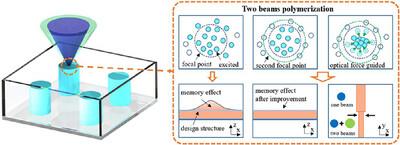Subdiffraction-Limit Glass 3D Printing by Optical Force-Guided Polymerization With Two Continuous Wave Lasers
IF 10
1区 物理与天体物理
Q1 OPTICS
引用次数: 0
Abstract
The realization of free-form silica glass nanostructures with sub-200 nm resolution represents a critical capability for advanced photonics and precision optics. Current femtosecond laser-based approaches remain constrained by high costs, low throughput, and restricted fabrication areas. A novel nanoscale additive manufacturing technique employing continuous-wave laser excitation is presented in a thermally curable polyhedral oligomeric silsesquioxane (POSS) photoresin, subsequently convertible to fused silica at 650 °C. The system utilizes synchronized coaxial laser beams to implement two distinct photochemical mechanisms: a two-color two-step absorption process for spatial confinement and optical force-guided polymerization (OFGP) for subdiffraction pattern refinement. This synergistic approach overcomes spatial resolution limitations imposed by the photopolymer's memory effect, achieving an exceptional feature size of 102 nm, surpassing the optical diffraction limit. Experimental validation demonstrates successful fabrication of high-fidelity curved surface architectures and programmable grayscale lithography with extended voxel modulation range. This dual-laser nanofabrication platform establishes a new paradigm for glass-based micro-optics production, combining nanoscale precision with industrial-scale throughput capabilities.

双连续波激光光力引导聚合的亚衍射极限玻璃3D打印
实现分辨率在200纳米以下的自由形式二氧化硅玻璃纳米结构,代表了先进光子学和精密光学的关键能力。目前基于飞秒激光的方法仍然受到高成本、低吞吐量和制造区域的限制。提出了一种利用连续波激光激发的纳米级增材制造技术,该技术采用热固化多面体低聚硅氧烷(POSS)光树脂,随后在650℃下可转化为熔融二氧化硅。该系统利用同步同轴激光束实现两种不同的光化学机制:用于空间约束的双色两步吸收过程和用于亚衍射图案细化的光学力引导聚合(OFGP)。这种协同方法克服了由光聚合物的记忆效应造成的空间分辨率限制,实现了102纳米的特殊特征尺寸,超过了光学衍射极限。实验验证了高保真曲面结构和扩展体素调制范围的可编程灰度光刻的成功制造。这种双激光纳米加工平台为基于玻璃的微光学生产建立了一个新的范例,将纳米级精度与工业规模的吞吐量能力相结合。
本文章由计算机程序翻译,如有差异,请以英文原文为准。
求助全文
约1分钟内获得全文
求助全文
来源期刊
CiteScore
14.20
自引率
5.50%
发文量
314
审稿时长
2 months
期刊介绍:
Laser & Photonics Reviews is a reputable journal that publishes high-quality Reviews, original Research Articles, and Perspectives in the field of photonics and optics. It covers both theoretical and experimental aspects, including recent groundbreaking research, specific advancements, and innovative applications.
As evidence of its impact and recognition, Laser & Photonics Reviews boasts a remarkable 2022 Impact Factor of 11.0, according to the Journal Citation Reports from Clarivate Analytics (2023). Moreover, it holds impressive rankings in the InCites Journal Citation Reports: in 2021, it was ranked 6th out of 101 in the field of Optics, 15th out of 161 in Applied Physics, and 12th out of 69 in Condensed Matter Physics.
The journal uses the ISSN numbers 1863-8880 for print and 1863-8899 for online publications.

 求助内容:
求助内容: 应助结果提醒方式:
应助结果提醒方式:


